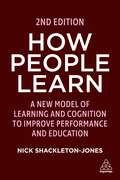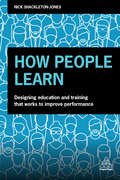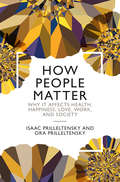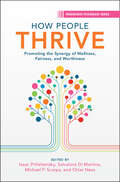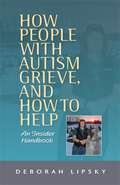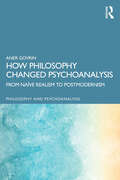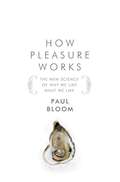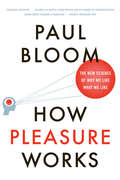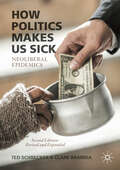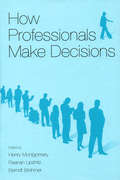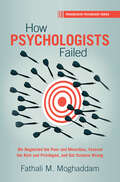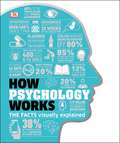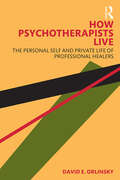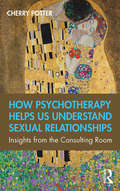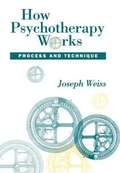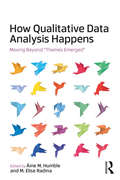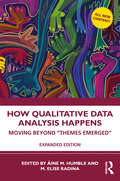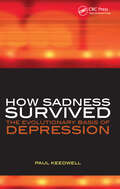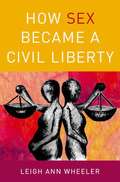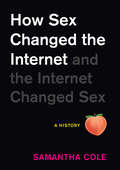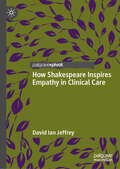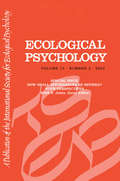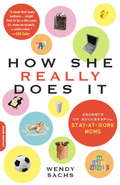- Table View
- List View
How People Learn: A New Model of Learning and Cognition to Improve Performance and Education
by Nick Shackleton-JonesHow can I design training so that it makes a real difference to employees' skills and development? This book gives L&D professionals everything they need to build effective learning experiences.How People Learn provides L&D professionals a new way of thinking about learning by exploring what happens when we learn. It shows how to apply insights from neuroscience, human behaviour and artificial intelligence (AI) to learning design including tips on how to interest, excite and engage staff in training. Using the author's '5Di model', this book demonstrates how to define, design and deploy training into existing workflows so it works both for and with employees. It also explores how simulations can be used to replicate a real-world challenge as closely as possible.The second edition features new material on learning in a hybrid world, and how to manage skills development and performance now that work, workplaces and workers have changed. It includes more practical guidance on building programmes with user-centred design and covers developments in the connection between learning and cognition, alongside case studies and examples from companies such as BP and the BBC.
How People Learn: Designing Education and Training that Works to Improve Performance
by Nick Shackleton-JonesWhat if we have been wrong about learning? Learning may have more in common with marketing than we thought. Looking at marketing and learning's common root, How People Learn shows L&D professionals a new way of thinking about learning by exploring what happens when we learn. It considers applications from AI, marketing and ethics and is informed by psychology and contemporary neuroscience in order to show L&D professionals how to design training with their employees and mind so that training makes a real difference to skills, capabilities, performance and development, rather than being a waste of time, money and resources. Using the author's '5Di model', How People Learn demonstrates how to define, design and deploy training in a user-centred way so it works both for and with employees. It also includes guidance on what training resources to create when employees are actively searching for learning content. Using this book, L&D practitioners will be able to use pull and push techniques to provide content that people use and experiences that transform their behaviour. From how to use simulations, storytelling and anticipation to the importance of observation and status, this book gives L&D professionals everything they need to build effective training programmes and learning experiences. With a forward by Dr Roger Schank, the Chairman and CEO of Socratic Arts and Executive Director of Engines for Education, and case studies from companies such as BP and the BBC, this is an urgent read for learning professionals.
How People Matter: Why it Affects Health, Happiness, Love, Work, and Society
by Isaac Prilleltensky Ora PrilleltenskyMattering, which is about feeling valued and adding value, is essential for health, happiness, love, work, and social well-being. We all need to feel valued by, and add value to, ourselves, others, co-workers, and community members. This book shows not only the signs, significance, and sources of mattering, but also presents the strategies to achieve mattering in our personal and professional lives. It uses research-based methods of change to help people achieve a higher sense of purpose and a deeper sense of meaning. Each chapter gives therapists, managers, teachers, parents, and healthcare professionals the tools needed to optimize personal and collective well-being and productivity. The volume explains how promoting mattering within communities fosters wellness and fairness in equal measure. By using the new science of feeling valued and adding value, the authors provide a guide to promoting happier lives and healthier societies.
How People Thrive: Promoting the Synergy of Wellness, Fairness, and Worthiness (Progressive Psychology)
by Isaac Prilleltensky Ottar Ness Salvatore Di Martino Michael P. ScarpaDiscover a groundbreaking perspective on personal and collective flourishing in this transformative book. Unveiling a dynamic synthesis of wellness, fairness, and worthiness, it presents a blueprint for thriving on personal, relational, occupational, systemic, community, and planetary scales. Move beyond the confines of individual well-being; embrace a holistic approach that encompasses entire groups, workplaces, communities, nations, and the world. While traditional psychology focused on personal thriving, the need for fostering the common good is now more urgent than ever-to combat pandemics, address climate change, champion peace, battle injustice, and elevate well-being globally. Dive into a compelling conceptual framework that guides theory, research, and action to tackle pressing global issues. This book pioneers a concise and powerful framework-three pillars of thriving: wellness, fairness, and worthiness. Join the movement towards a world where collective thriving is not just a goal, but a reality for all.
How People with Autism Grieve, and How to Help: An Insider Handbook
by Deborah LipskyThe book is an honest, first-hand account of how people with autism deal with the loss of someone in their life. Unlike the non-autistic response, people with autism, when faced with overwhelming or stressful situations, will favour solitude over sharing their emotions, tend to focus on special interests, and become extremely logical, often not expressing any emotion. This behaviour often leads to the belief that people with autism lack empathy, which is far from the case. Through the description of personal experience, and case studies, the book explores how people with autism feel and express the loss of a loved one, how they process and come to terms with their feelings of grief, and offers practical and detailed advice to parents and carers on a range of sensitive issues. These include clear instructions on how best to support someone with autism through the grieving process, how to prepare them for bad news, how to break the bad news, how to involve them in the funeral or wake, and how best to respond to later reactions. The final chapter explores the issue of why children and teens with autism can be drawn to death as a special interest, and explains that the interest is not normally a morbid one.
How Philosophy Changed Psychoanalysis: From Naïve Realism to Postmodernism (Philosophy and Psychoanalysis)
by Aner GovrinThrough this book, philosopher and psychoanalyst Aner Govrin demonstrates how psychoanalysis’ engagement with philosophy was crucial in the evolution of new psychoanalytic theories in three areas: perception of truth, developmental theories, and study of psychoanalytic treatment.Beginning with a Freudian perspective, through ego psychology to the intersubjective and the relational approach, Govrin shows that philosophy seeps into psychoanalytic theory itself, becoming a constitutive factor. When we discuss psychoanalysis, we cannot do it without reference to philosophy, since virtually every sentence it has generated harks back to and is embedded in philosophy. Moving onto the Post-psychoanalytic Schools Era in the second part, this seminal volume provides a model for understanding the evolution of psychoanalytic thought in the postmodern era, where “sensibilities” like the relational approach and infant research replaced the orthodox psychoanalytic schools. Govrin also explores whether psychoanalysis is a branch of philosophy, how psychoanalysis progresses, what a psychoanalytic innovation is, and why mainstream psychoanalysis rejects neuropsychoanalysis.Exploring the intricate relationship between psychoanalysis and philosophy, this book will be of interest to clinicians, scholars, teachers, and students of contemporary psychoanalysis across a broad spectrum of theoretical orientations, as well as those in philosophy of science, epistemology, and neuropsychoanalysis.
How Pleasure Works: The New Science Of Why We Like What We Like
by Paul BloomPleasure is anything but straightforward. Our desires, attractions, and tastes take us beyond the symmetry of a beautiful face, the sugar and fat in food, or the prettiness of a painting. In How Pleasure Works, Yale University psychologist Paul Bloom draws on groundbreaking research to unveil the deeper workings of why we desire what we desire. Refuting the longstanding explanation of pleasure as a simple sensory response, Bloom shows us that pleasure is grounded in our beliefs about the deeper nature or essence of a given thing. This is why we want the real Rolex and not the knockoff, the real Picasso and not the fake, the twin we have fallen in love with and not her identical sister. In this fascinating and witty account, Bloom draws on child development, philosophy, neuroscience, and behavioral economics in order to address pleasures noble and seamy, highbrow and lowbrow. Along the way, he gives us unprecedented insights into a realm of human psychology that until now has only been partially understood.
How Pleasure Works: The New Science Of Why We Like What We Like
by Paul Bloom"Engaging, evocative. . . . [Bloom] is a supple, clear writer, and his parade of counterintuitive claims about pleasure is beguiling."--NPR Why is an artistic masterpiece worth millions more than a convincing forgery? Pleasure works in mysterious ways, as Paul Bloom reveals in this investigation of what we desire and why. Drawing on a wealth of surprising studies, Bloom investigates pleasures noble and seamy, lofty and mundane, to reveal that our enjoyment of a given thing is determined not by what we can see and touch but by our beliefs about that thing's history, origin, and deeper nature.
How Politics Makes Us Sick: Neoliberal Epidemics
by Ted Schrecker Clare BambraThis book makes a powerful case that neoliberalism, the dominant economic and social policy paradigm of the post-1980 world, is hazardous to our health. It describes the destructive effects on health and health inequalities of neoliberal policies including labour market deregulation, welfare state retrenchment, and austerity, drawing on cross-national examples particularly from the United States and the United Kingdom. The book argues that a variety of adverse health outcomes, and in particular health inequalities, must be seen as ‘neoliberal epidemics’: neoliberal because they are associated with the rise of neoliberal politics; epidemics because they have been rapidly transmitted across borders at a rate seen in epidemics of biological contagions. The health case against neoliberalism has strengthened dramatically in the decade since the first edition was published and this fully updated and expanded edition provides a comprehensive overview of the main issues. Articulating alternatives that protect the health of people and planet is more urgent than ever. Crucially, the authors argue that neoliberal epidemics require a political cure in the form of a revitalised and equity-oriented social democracy.
How Professionals Make Decisions (Expertise: Research and Applications Series)
by Raanan Lipshitz Henry Montgomery Berndt BrehmerThis volume is the fruit of the 5th conference on Naturalistic Decision Making which focused on the importance of studying people who have some degree of expertise in the domain in which they make decisions. The substantive concerns pertain to how individuals and groups make decisions in professional and organizational settings, and to develop suit
How Psychologists Failed: We Neglected the Poor and Minorities, Favored the Rich and Privileged, and Got Science Wrong (Progressive Psychology)
by Fathali M. MoghaddamPsychology is a discipline with global influence, but continues to neglect disadvantaged minorities and continues to adopt an incorrect model of science. This volume explains what has gone wrong, and what steps should be taken for psychology to become a constructive international force. Historically, psychologists have focused only on causal explanations of behavior, neglecting normatively regulated behavior and intentionality. By giving greater importance to context and collective processes, moving from 'societies to cells,' psychologists can better understand and explain individual behavior. Poverty is an extremely powerful context that shapes cognitions and actions, with destructive consequences for disadvantaged individuals. The advocation of 'be happy psychology' and 'resilience' as solutions to problems faced by the disadvantaged leads to entrenched group-based inequalities, with the poor stuck at the bottom. Moving forwards, this volume proposes that psychologists should focus on normative systems to ultimately foster a more balanced field of study for the future.
How Psychology Works: Applied Psychology visually explained, First Edition
by Dorling Kindersley LimitedHow Psychology Works explains hundreds of psychological terms clearly and simply, such as neurosis, psychosis, psychopathy, self-efficacy, flow, human factors, and false memory syndrome.
How Psychotherapists Live: The Personal Self and Private Life of Professional Healers
by David E. OrlinskyHow Psychotherapists Live is a landmark study of thousands of mental health practitioners worldwide. It significantly advances our understanding of psychotherapists and counselors by focusing on their individual qualities and lives, revealing the many ways they differ as persons and how those differences shape their experiences of therapeutic work. Topics include the therapist's personal self, private life, individual beliefs, quality of life, childhood family experiences, and personal psychotherapy. Based on thirty years of research, the book is written to interest clinical practitioners while also providing researchers with a rich array of data. Clinical psychologists, psychiatrists, clinical social workers, and counselors can easily compare their own experiences with the thousands of therapists in the study by reflecting on typologies constructed from research findings. The book will also be a valuable resource for researchers studying the sources of variation in therapists' effectiveness.
How Psychotherapy Helps Us Understand Sexual Relationships: Insights from the Consulting Room
by Cherry PotterIn this fascinating book, Cherry Potter takes readers on her personal and professional quest for insights into sex, relationships and gender differences. Why do we feel what we feel, and do what we do? What is the impact of ‘performance anxiety’ on men, and on society generally? Why are women still faking it? Is ubiquitous online porn turning the clock backwards? The book delves into the work of Freud, Klein, Bowlby and recent developments in attachment theory for insights into our conscious and unconscious fears and desires, and introduces readers to a range of fascinating clients. These include Jeremy, who was so ashamed of his virginity he was unable to have a relationship; Ellie, who repeatedly fell in love with unobtainable men; Kieran, whose fear of abandonment threatened to wreck his gay relationships; Dulcie, who for years had been unable to face the truth that her husband was having multiple affairs; and Lars, who was addicted to online porn and prostitutes. The book shows how the work between therapist and client is a process of learning together, which is at times painful and deeply moving, but can also reflect a renewed vitality and hope for the future, particularly when it comes to talking about sex. How Psychotherapy Helps Us Understand Sexual Relationships: Insights from the Consulting Room will be of great interest to both the general reader as well as psychotherapists and counsellors.
How Psychotherapy Works: Process and Technique
by Joseph Weiss<P>In the landmark volume, THE PSYCHOANALYTIC PROCESS, Joseph Weiss presented a bold, original theory of the therapeutic process. Now, in HOW PSYCHOTHERAPY WORKS, Weiss extends his powerful theory and focuses on its clinical applications, often challenging many familiar ideas about the psychotherapeutic process. <P>Weiss' theory, which is supported by formal, empirical research, assumes that psychopathology stems from unconscious, pathogenic beliefs that the patient acquires by inference from early traumatic experiences. He suffers unconsciously from these beliefs and the feelings of guilt, shame, and remorse that they engender, and he is powerfully motivated unconsciously to change them. According to Weiss's theory, the patient exerts considerable control over unconscious mental life, and he makes and carries out plans for working with the therapist to change his pathogenic beliefs. He works to disprove these beliefs by testing them with the therapist. The theory derives its clinical power not only from its empirical origin and closeness to observation, and also from Weiss's cogent exposition of how to infer, from the patient's history and behavior in treatment, what the patient is trying to accomplish and how the therapist may help. By focusing on fundamental processes, Weiss's observations challenge several current therapeutic dichotomies--"supportive versus uncovering," "interactive versus interpretive," and "relational versus analytic." <P>Written in simple, direct language, Weiss demonstrates how to uncover the patient's unconscious plan and how the therapist can help the patient to carry out his plans by passing the patient's tests. He includes many examples of actual treatment sessions, which serve to make his theory clear and usable. The chapters include highly original views about the patient's motivations, the role of affect in the patient's mental life, and the therapist's basic task. The book also contains chapters on how to pass the patient's tests, and how to use interpretation with the patient. Dr. Weiss also provides a powerful theory of dreams and demonstrates how dreams can be utilized in clinical practice. <P>This distinguished volume is a major contribution that will profoundly affect the way one conceptualizes and practices therapy. Theoreticians, investigators, and clinicians alike will find it enlightening reading.
How Qualitative Data Analysis Happens: Moving Beyond "Themes Emerged"
by Áine Humble Elise RadinaWinner of the 2020 Anselm Strauss Award for Qualitative Family Research, National Council on Family Relations. How is qualitative data actually collected, analyzed, and accomplished? Real stories of How Qualitative Data Analysis Occurs: Moving Beyond "Themes Emerged" offers an in-depth look into how qualitative social science researchers studying family issues and dynamics approach their data analyses. It moves beyond the usual vague statement of "themes emerged from the data" to show readers how researchers actively and consciously arrive at their themes and conclusions, revealing the complexity and time involved in making sense of thousands of pages of interview data, multiple data sources, and diverse types of data. How Qualitative Data Analysis Occurs focuses on a diversity of topics in family research across the life course. The various authors provide detailed narratives into how they analyzed their data from previous publications, and what methodologies they used, ranging from arts-based research, autoethnography, community-based participatory research, ethnography, grounded theory, to narrative analysis. Supplemental figures, images, and screenshots which are referred to in the chapters, are included in an accompanying eResource, as well as links to the previously published work on which the chapters are based. This book is an invaluable resource for experienced and novice qualitative researchers throughout the social sciences.
How Qualitative Data Analysis Happens: Moving Beyond “Themes Emerged”
by Áine M. Humble M. Elise RadinaHow Qualitative Data Analysis Happens: Moving Beyond “Themes Emerged”, offers an in-depth look into how qualitative social science researchers studying a wide range of human experiences and dynamics approach their data analyses. This expanded edition consists of 13 new chapters from a broad range of disciplines (and an added conclusion) that document the stories about how qualitative data analysis occurred.Chapters for this expanded edition represent a diversity of disciplines (e.g., criminology, family science, education, health, nutrition, sociology, sport psychology) that focus on the human experience and describe a diversity of methodological approaches. These chapters may be used to introduce readers to newer or innovative ways of analysing data. It moves beyond the usual vague statement of “themes emerged from the data” to show readers how researchers actively and consciously arrive at their themes and conclusions, revealing the complexity and time involved in making sense of thousands of pages of interview data, multiple data sources, and diverse types of data. The various authors provide detailed narratives into how they analysed their data from previous publications. The methodologies range from arts-based research, autoethnography, community-based participatory research, ethnography, grounded theory, to narrative analysis. The volume allows readers to be seemingly “in the room” with these international scholars (representing Canada, the US, Austria, Germany, the UK, and the Philippines) and getting their own hands vicariously dirty with the data.This expanded edition also includes a conclusion chapter, in which the authors reflect on commonalities across the chapters. Supplemental figures, images, and screenshots, which are referred to in the chapters, are included in an accompanying eResource (that can be accessed at www.routledge.com/ 9781032183213), as well as links to the previously published work on which the chapters are based. This book is an invaluable resource for experienced and novice qualitative researchers throughout the social sciences, as well as undergraduate and postgraduate students in the field.
How Sadness Survived: The Evolutionary Basis of Depression
by Philip Barker Paul Keedwell"What I am offering is a critical overview of ideas about depression, some new, some old, which fall under the discipline of 'evolutionary psychology'(EP). Do most types of depression represent an adaptation - an evolved mechanism which has improved our survival and reproductive value in our ancestral environment? Has depression been selected? Coul
How Sex Became a Civil Liberty
by Leigh Ann WheelerHow Sex Became a Civil Liberty is the first book to show how and why we have come to see sexual expression, sexual practice, and sexual privacy as fundamental rights. Using rich archival sources and oral interviews, historian Leigh Ann Wheeler shows how the private lives of women and men inthe American Civil Liberties Union shaped their understanding of sexual rights as they built the constitutional foundation for the twentieth-century's sexual revolutions. Wheeler introduces readers to a number of fascinating figures, including ACLU founders Crystal Eastman and Roger Baldwin; nudists, victims of involuntary sterilization, and others who appealed to the organization for help; as well as attorneys like Dorothy Kenyon, Harriet Pilpel, and Melvin Wulf,who pushed the ACLU to tackle such controversial issues as abortion and homosexuality. It demonstrates how their work with the American Birth Control League, Planned Parenthood Federation, Kinsey Institute, Playboy magazine, and other organizations influenced the ACLU's agenda. Wheeler explores the ACLU's prominent role in nearly every major court decision related to sexuality while examining how the ACLU also promoted its agenda through grassroots activism, political action, and public education. She shows how the ACLU helped to collapse distinctions between public andprivate in ways that privileged access to sexual expression over protection from it. Thanks largely to the organization's work, abortion and birth control are legal, coerced sterilization is rare, sexually explicit material is readily available, and gay rights are becoming a reality. But this bookdoes not simply applaud the creation of a sex-saturated culture and the arming of citizens with sexual rights; it shows how hard-won rights for some often impinged upon freedoms held dear by others.
How Sex Changed the Internet and the Internet Changed Sex: An Unexpected History
by Samantha ColeFrom the moment there was an &“online,&” there was sex online. The famous test image used by software engineers to develop formats like the jpeg was &“Lena,&” taken from Playboy&’s November 1972 centerfold. Early bulletin boards and multi-user domains quickly came to serve their members sexual musings. Facebook started as a way to rate &“hot or not&” Harvard co-eds. In fact, virtually every significant development that defines the Internet we know and love (and hate) today—privacy issues, online payments and online banking, dating, social media, streaming technology, mass data collection—came out the meeting of sexuality and technology. Not only did sexuality vastly influence the internet, but the internet arguably changed modern sexuality by giving every imaginable non-hetereonormative community a safe place to explore, fantasize, thrive, and be accepted. Which of course only led to more exploring, more fantasizing, more thriving. A lively, highly visual history, filled with broad themes and backstories, pioneering personalities and eureka-moments, How Sex Changed the Internet and the Internet Changed Sex covers everything from Jennicam (remember her?) to deep fakes. And most of what came in between, including &“A Brief History of Online Dating&” and the promise that VR spaces like the metaverse hold for the future of human sexual interactions. Porn is just one part of the story. Rather, this is a story about human nature during the digital gold rush of the last fifty years.
How Sex Changed: A History of Transsexuality in the United States
by Joanne MeyerowitzHow Sex Changed is a fascinating social, cultural, and medical history of transsexuality in the United States. Joanne Meyerowitz tells a powerful human story about people who had a deep and unshakable desire to transform their bodily sex. In the last century when many challenged the social categories and hierarchies of race, class, and gender, transsexuals questioned biological sex itself, the category that seemed most fundamental and fixed of all. From early twentieth-century sex experiments in Europe, to the saga of Christine Jorgensen, whose sex-change surgery made headlines in 1952, to today's growing transgender movement, Meyerowitz gives us the first serious history of transsexuality. She focuses on the stories of transsexual men and women themselves, as well as a large supporting cast of doctors, scientists, journalists, lawyers, judges, feminists, and gay liberationists, as they debated the big questions of medical ethics, nature versus nurture, self and society, and the scope of human rights. In this story of transsexuality, Meyerowitz shows how new definitions of sex circulated in popular culture, science, medicine, and the law, and she elucidates the tidal shifts in our social, moral, and medical beliefs over the twentieth century, away from sex as an evident biological certainty and toward an understanding of sex as something malleable and complex. How Sex Changed is an intimate history that illuminates the very changes that shape our understanding of sex, gender, and sexuality today.
How Sexual Desire Works
by Frederick ToatesThere are countless books on sex and an endless fascination with the subject. Varieties and vagaries of sexual desire have long been documented, but there has been little engagement with cutting-edge scientific research to uncover the biological and psychological bases of sexual desire. Here, Frederick Toates uses the insights of modern science to show how a wide range of desire-related phenomena - fantasy, novelty-seeking, sexual addiction, sex-drug interactions, fetishes, voyeurism, and sexual violence and killing - start to make sense. For example, the role of the brain's neurochemical dopamine can now be much better understood in terms of wanting, and a distinction between wanting and liking has been established. Also, an understanding of the layered organization of the brain, sometimes described as hierarchical, can be used to explain temptation and conflict. This is a fascinating book with great social relevance to society and its problems with sexuality.
How Shakespeare Inspires Empathy in Clinical Care
by David Ian JeffreyThis book investigates how a study of Shakespeare’s plays may enhance empathy in doctors, nurses, and other healthcare professionals. Addressing the widely perceived empathy gap in teaching and medical practice that emerged after the Covid-19 pandemic, the book presents a new study into the psychosocial elements of human interactions. It offers invaluable insights into how students and practitioners may be supported in dealing appropriately with their emotions as well as with those of their patients, thereby facilitating more humane medical care. Fostering an empathic patient-doctor relationship, the author explores the emotional, cognitive and moral dimensions of care and describes how Shakespeare studies can be realistically incorporated into the medical curriculum through group reflections, workshops and special study modules.
How Shall Affordances Be Refined?: Four Perspectives:a Special Issue of ecological Psychology
by Keith S. JonesWhat should and should not be considered an affordance is still an open issue. This special issue expands on the 2002 North American meeting of the International Society for Ecological Psychology covering this topic. The first article argues that affordances are properties of the animal-environment system and are emergent properties that do not inhere in either the environment or the animal. The next paper focuses on four issues regarding affordances: the ontological status, whether or not they are necessarily related to (one's own) actions, the relation between affordances and effectivities, and the nesting of affordances. Finally, several exemplars of phenomenologically driven perceptual research are examined, as well as the advantages over extant theories of affordances.
How She Really Does It: Secrets of Successful Stay-at-Work Moms
by Wendy SachsThe kids are sick but the boss needs the presentation on her desk by ten. The parent-child kindergarten brunch can’t be missed, yet the business meeting beckons. When the only thing she knows for sure is that her day will bring a new set of challenges and priorities to be juggled, how does a stay-at-work mom do it all?Wendy Sachs, stay-at-work mother of two, has interviewed women from every walk of life- from celebrities like makeup maven Bobbi Brown, designer Vera Wang, CNN’s Soledad O’Brien, the Today Show’s Ann Curry to everyday moms from all over the country-and has uncovered some inspiring answers. For starters, some stay-at-work moms have given up striving for balance; for true happiness and sanity, integration is the real key. Others have discovered that compartmentalization-wearing different hats at different times of day-is the only way to thrive. For all, the psychological, emotional, and financial payback of work is what keeps them feeling alive; even if they could afford not to work (and many can afford the choice), they wouldn’t have it any other way. Demonstrating that a byproduct of having career ambition is a happier marriage and family, How She Really Does It will validate the millions of women now attempting to "have it all,” or at least some of it all the time. Revealing the keys to staying-at-work, staying sane, staying satisfied, and staying at the heart of her family as well, How She Really Does It is a modern working woman’s handbook.
